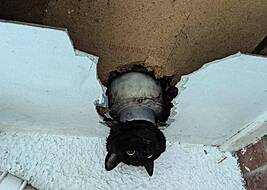We’ve all heard of the outdoor air pollution that’s seriously damaging the environment. But what about the indoor air pollution that’s damaging our health?
Indoor air contains a myriad of particles we can’t see or always smell, including pet dander, human and pet skin scales, dust mites, mould, and chemicals such as petrol and gas fumes, ammonia and perfumes, explain indoor air quality experts Jeff and Connie May, who say such pollutants can damage health through causing allergies, asthma and lung inflammation.
“We inhale fragments of the spaces around us with every breath,” Jeffrey points out. “Many of the contaminants, allergens, irritants and chemicals to which people are exposed indoors, aren’t readily recognised and can even be invisible to the naked eye.
“Some of us tend to be suspicious, or even disbelieving, when people with whom we live or work seem to be reacting to some unseen substances in indoor air. Perhaps if we could see these substances – the way we can see smoke, we would all be more understanding.
“By better controlling the indoor environmental conditions where we live and work, we can minimise the symptoms we or those we know or love may be experiencing, because of indoor air quality problems.”
The couple have written the book My House Is Killing Me! to help people identify the sources of indoor pollution in their homes, and in the foreword to the book, pulmonary specialist Dr Jonathan Samet, who’s done extensive research on the health risks of air pollutants, says: “Problems in indoor environments can seriously damage health, and these problems can be identified and solved.”
Here, the Mays highlight some of the sources of indoor air pollution that can damage our health…
The kitchen
Kitchen cabinet kick spaces can collect dust and, when dampened by floor mopping can become “mould farms”, so be sure to remove any mould and dust.
Flour moths produce allergenic faecal matter. Be cautious about buying unpackaged grains, which can contain flour moths.
Fridges create airflows that can spread by-products of microbial growth (bacteria, yeast, mould) in the drip trays. Clean the drip pan and coils in your fridge at least annually.
Sponges with bacterial growth emit the nasty odour of butyric acid – like the smell of vomit. To prevent it, soak a smelly sponge in a water/ammonia mixture, or run it through the dishwasher.
Bathroom
Leaking taps can rot the cabinet beneath, so repair or replace them.
Bottom of toilet tank mould can grow due to dust and moisture from condensation in humid weather, so try to remove dust from the bottom if you can.
A leaking bath overflow results in damage and mould growth to the wall and ceiling cavities beneath the bath. To help stop this, don’t fill your bath above the overflow.
Dry drain and/or rocking toilet – sewer gas can backflow through a dry drain or a damaged wax toilet ring. To stop this, put a cup or so of water into a drain that isn’t used regularly on a weekly basis, and have the wax toilet ring replaced if your toilet rocks.
Excess moisture in a bathroom can result in condensation and mould growth on the walls and ceiling. Reduce moisture levels by keeping the door open and the extractor fan running for an hour or two after bathing and showering. Use an oscillating fan to dry walls, and remove surface mould growth with a dilute bleach solution (one part bleach to 16-18 parts water), or with a cleaning agent.
Utility room

Front-loading washing machines can encounter mould growth on a door gasket, which emit strong musty smells. Keep the outer and inner surfaces of the door gasket clean, and keep the door and dispenser drawer open between loads.
A leaking dryer hose emits laundry chemicals, potentially irritating lint, and moisture that can fuel mould growth. If you see lint behind the dryer, the exhaust hose may be loose or leaking, so repair if necessary.
Bedrooms
Feather pillows and quilts that haven’t been washed properly can emit allergenic bird dander and bird-bloom particles. Exposure to bird-bloom particles can cause the respiratory illness ‘duvet lung,’ a type of hypersensitivity pneumonitis (HP). So, if you have allergies, asthma, or other environmental sensitivities, avoid having feather-filled bedding.
Mattresses and other pillows can cause exposure to dust-mite allergens, and is one of the major triggers for asthma and allergy. Mattresses and pillows can gather dust that can easily be inhaled when you go to bed, so do your best to reduce the risk by putting dust mite encasings with polyurethane liners on all mattresses and bed pillows.
Living room
Antique furniture that’s been stored in a damp basement or garage can contain mould growth, so if you have a mould allergy, be cautious about buying antiques.
Wool rugs – when wool fibres deteriorate, they emit wool cuticle and wool cortex particles, that can be irritating to inhale.
Wall-to-wall carpeting can contain mould growth and microarthropod infestations, including dust mites. If you think you may be sensitive to dust and mould, bear in mind that hard flooring is easier to clean and collects less dust than wall-to-wall carpeting.
Jar candles emit soot particles, which stain walls and ceilings, and are unhealthy to inhale. So, just don’t burn them!
Cleaning products
Fragranced products add to the chemical load of indoor air, and some people are sensitive to them, and may wheeze or cough if they inhale a fragrance.
Some laundry detergents contain enzymes including ‘stain lifters’, subtilisin, and anything ending in “ase” such as protease. These substances can cause a small number of sensitised people to experience allergy symptoms, such as coughing, skin irritation, and even fatigue. So if you’re sensitised, avoid laundry detergents containing enzymes.
Vacuum cleaners can emit particulates including allergens, so always use a HEPA vacuum (high efficiency particulate arrestance filtration) with a bag. And if you hire cleaners, insist they use your vacuum and not their own.
My House is Killing Me! A Complete Guide To A Healthier Indoor Environment by Jeffrey & Connie May is published by Johns Hopkins University Press. Available now.







